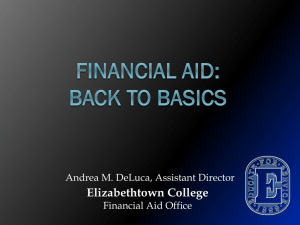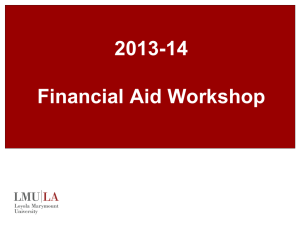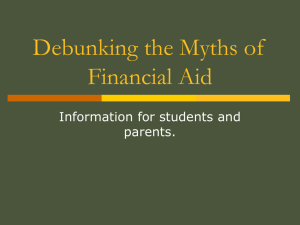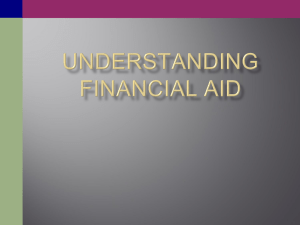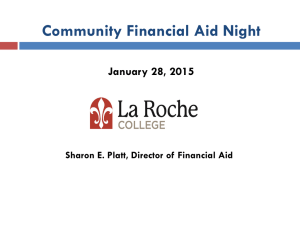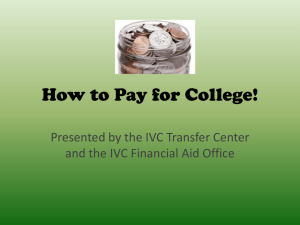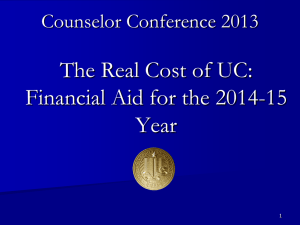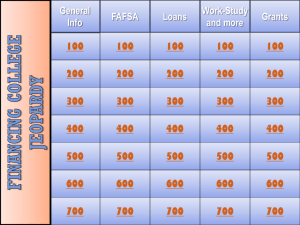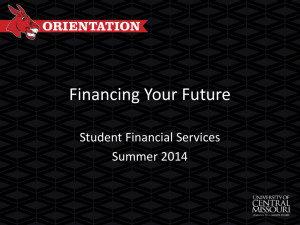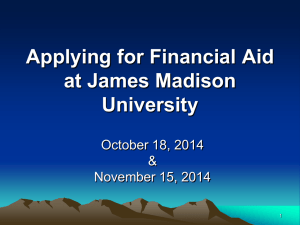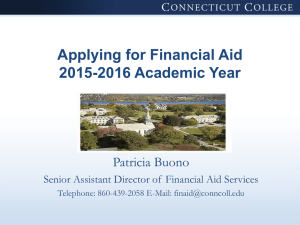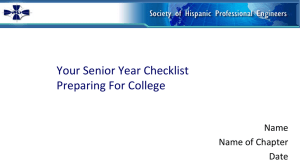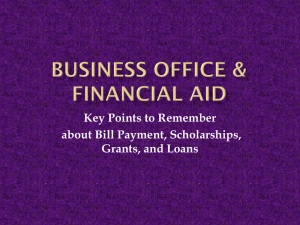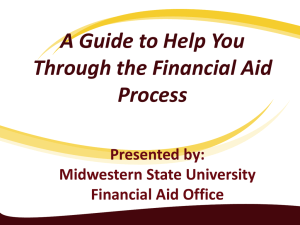College Financing Workshop - Montgomery County Public Schools
advertisement
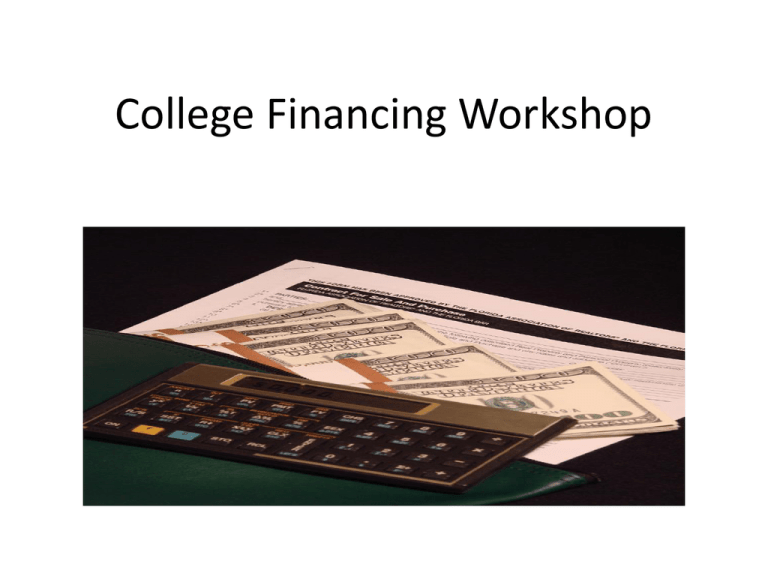
College Financing Workshop Workshop Agenda • • • • • • • • Getting ready- the college calendar How much does College Really Cost Debunking college financing myths Types of financial aid- grants, scholarships, work & loans, academic common market. What is the Net Price Calculator The application process- (FAFSA, CSS Profile, and other forms) Evaluating Financial Aid Awards Scholarship Opportunities The College Calendar • Make sure you check out the specific deadlines for schools of interest. • November-March • If applying Early Decision, some schools require the CSS Financial Aid Profile Form by a certain deadline as well as the students application. (Only required by about 500 schools) • Many schools have scholarship application deadlines. (Check the schools web-site for details) • Starting in November you can obtain the FAFSA-on-the-Web Pre-Application Worksheet (www.fafsa.ed.gov) • January-February: Submit FAFSA- State of Maryland deadline is March 1. College Calendar • February-April: Notifications from colleges will begin, followed by financial aid award letters. Watch for email notifications if the school has requested additional documents. Email notifications may be listed on the student’s college account. May 1: Send tuition & housing deposits (most schools require this) STAY ORGANIZED • Financial Aid File – FAFSA- File EVERY YEAR – CSS Profile Form (if required)- Every Year – Student Aid Report Information (SAR) – Copies of Tax Returns & W-2s – Copies of any corrections – Copies of school financial forms MEET ALL DEADLINE DATES The Financial Aid Equation How Much Does College Really Cost • COA-EFC=NEED – COA is Cost of Attendance (tuition, room, board, fees) – EFC is Expected Family Contribution ( estimated by the federal government. What you can pay for your child’s tuition per year based on your income, assets, savings) Financial Aid Myths • Scholarships will pay our student’s college costs. Reality: Only 4% of total financial aid is in the form of merit or talent-based scholarships. • Our family makes too much money to qualify for financial aid Reality: Many factors beyond annual income are considered in determining a family’s ability to pay for college expenses. These include family size, net value of assets, age of parents, number of children in college, and special circumstances. • The equity in our home will make our child ineligible for financial aid Reality: Federal and state formulae do not consider home equity. Some independent institutions do review home equity but often adjust it relative to family income. Home equity is requested on the CSS Profile Form • Our other assets will make our child ineligible Reality: Parental assets are protected for retirement. Parental assets have no effect on eligibility for 95% of applications. Or the remaining five percent, no more than 5.7% of parents’ net assets (savings investments, equity) are used in determining eligibility for aid. Retirement funds (IRA, 401K, 403b, etc.)are not considered assets (except for CSS Profile Form) but pre-tax amounts contributed in the prior tax year are considered untaxed income. Financial Aid Myths • I am not an A student or an athlete, so I will not be eligible for financial aid Reality: Most financial aid is awarded on the basis of the economic situation of the parents and student. There are also funds available to students with special talents. • Financial aid is available only to minorities Reality: Although a few scholarships are based on race, gender, disability, or other factors, the overwhelming amount of money is awarded on the basis of financial need. Awards based on academic ability, athletic, and other special talents, and community service also exceed awards based on minority status. • Big, prestigious colleges will award more aid Reality: Every college makes its own decisions about how much aid to offer. Big colleges have big expenses, and some small colleges have large endowments or other financial aid resources. • More non-education debt will get me more financial aid Reality: Need analysis formulas do not consider consumer or mortgage debt. Financial Aid Myths • I will have to go deeply into debt in order to go to college Reality: Most students graduate with less debt than the cost of a single year of private school tuition. A good rule of thumb is not to borrow more during college than your expected starting annual salary when you graduate. • Student employment hurts grades Reality: On average, students who work up to 15 hours per week actually get better grades than those who do not work. • My neighbor did not get financial aid, so neither will I Reality: Your neighbor is not you. He or she may have significantly different financial circumstances than you do, despite outward appearances. Your neighbor’s child may have attended a lower cost school, or your neighbor may want you to think he or she is not receiving support. The only way to learn if you are eligible for financial aid is to apply for it. If you do not apply, you definitely will not receive assistance. In addition eligibility rules for financial aid change each year as do family circumstances. Financial Aid Myths • I should wait until I have filed tax returns before applying for financial aid. Reality: Meet the application DEADLINES!! Yes it is easier to complete the forms after tax returns have been completed, but it is far worse to miss a deadline. If you have not completed your tax returns by the application deadlines, estimate as closely as possible the information you report on FAFSA and provide corrections later if needed. • I should wait until I am admitted before applying for financial aid Reality: ONCE AGAIN MEET ALL DEADLINES!!! Many application deadlines for financial aid are earlier than the dates the colleges announces admission decisions. If you do not meet the financial aid deadline, you may not be awarded some aid because funds will be exhausted by the time you apply. By meeting the deadline, you will be considered fully for all financial aid funds. • Applying for financial aid will hurt my chances for admission Reality: Most colleges practice “aid blind” admission, which means they make decisions without regard to ability to pay. ASK the schools directly what their policy is. Are they “need-blind”, “need-assistance”, “need-aware”. • I will not qualify for financial aid because I have saved money for college. Reality: The federal government uses only 20% of the student assets as part of the family contribution. For instance, if a student has $5,000 in savings, the change to the family contribution would be $1,000. $5,000X20%=$1,000. • If my parents do not claim me on their tax return, I will get more aid Reality: Not true- A student must meet the Independent Student Criteria* Types of Financial Aid GRANTS-SCHOLARSHIPS-WORK-LOANSACADEMIC COMMON MARKET • Grants (Gift Aid based on NEED) • Scholarships (Gift Aid based on merit/talent) • Work-Study • Educational Loans (student & parent loans) • Academic Common Market (Only offered for certain majors not offered by any Maryland Public Schools, and with participating states) SEE ACADEMIC COMMON MARKET WEB PAGE Financial Aid Award Packaging • Availability of funds and institutional policy will influence amount and type of aid offered. (for example work study & institutional grants) • Remember many scholarships will have requirements the student must maintain to keep. • Many schools are unable to meet full federal financial aid eligibility (need) due to limited resources. • All schools use different need analysis methodologies to distribute aid. Maximum amounts allowed: Federal Pell Grant: $5,500 TEACH Grant*: $4,000 Federal Stafford Loan: $5,500 Federal Perkins Loan: $5,500 Federal Supplement Educational Opportunity Grant: $4,000 Federal Work-Study: depends on funds available at school Federal PLUS Loan (for parents only) COA minus other aid received. Must contact school directly for exact estimate. Types of Educational Loans • • • • • • • Federal Perkins Loan Federal Stafford Loans Federal PLUS (Parental) Loan Private or Institutional Loans Institutional Monthly Payment Plan Some families use home equity loans Interest paid on student loans is deductible on federal tax returns for many middle income students and parents WHAT ARE Subsidized & Unsubsidized Loans?? SUBSIDIZED Need Based No Payments or interest while in school Payments & interest begin 6 months after graduation Low interest rate from government Repayment options from 10-25 years UNSUBSIDIZED Eligibility not based on income or need Interest begins when funds are disbursed Defer interest or pay interest while in school What is the Net Price Calculator? • Every College is required to have a Net Price Calculator on their website. • This tool will help you get an estimate based on your personal situation.( Only as good as the information submitted) • Understand the finanical resources available for a particular school.(Some schools use sophisticated analysis, others use averages) • REMEMBER to ask about Mandatory FEES that may not be included in tuition. • Contact the schools financial aid office or Bursar HOW TO APPLY FOR FINANCIAL AID • #1. Both Student and Parent NEED TO GET A PIN- WWW.PIN.ED.GOV • FILE FAFSA- (FREE APPLICATION FEDERAL STUDENT AID) ALL SCHOOLS • WWW.FAFSA.ED.GOV (WATCH OUT FOR SCAMS IF YOU GOOGLE FAFSA)OPTIONAL USE THE FAFSA WORKSHEET TO GET READY • FILE ONLINE AFTER JANUARY, 1 2014 • IF NEEDED COMPLETE THE CSS AID PROFILE • www.student.collegeboard.org/css-financial-aid-profile Financial Aid Application Materials • 2013 Federal tax Returns • All W-2 forms • FAFSA- Taxed and untaxed income of custodial parent(s) and student • Number of family members/Number of dependent children in college at least ½ time for at least 1 academic term • Age of parent • Net assets (checking, savings, investments, ‘other’ real estate equity, business and farm equity) • Maryland DEADLINE is MARCH 1, 2014 or the earliest college deadline-whichever comes first Comparing the Forms FAFSA • About 100 questions • Free to file • Income Driven – Adjusted Gross Income (AGI) of both the student and parent(s) • Asset Information – Asset protection for parents • Special Circumstances – Can’t be reported on FAFSA, must talk with each school separately CSS Profile • About 300 questions • Charged a fee to file • Income Information (same as FAFSA) • Asset Driven – Home Equity & Retirement Savings – Assets in sibling’s name – Prior Year & Future Year Income (est.) • Special Circumstances – Open narrative box to add Common Mistakes on the FAFSA • Leaving a field Blank (If the answer is zero, write “0”) • Not using legal name as it appears on the student’s Social Security Card. Or Using the Incorrect SS #. • The words “YOU” and “YOUR” on the FAFSA always refer to the STUDENT, not the parents. • Confusing “total income tax” with adjusted gross income, taxes withheld, or taxes due. • Listing retirement assets as investments. • Not reporting Earned Income Credit, retirement contributions, combat pay, and military food and housing allowances as “untaxed income”. • Not counting the student as a member of the family and/or as a family member who will be attending college. • Not listing colleges you want to receive the report, or listing the wrong college with the wrong Federal School Code. • Not reporting the student’s housing plans for each college. • Not signing the form with the required PIN number for PARENT & STUDENT. • Failing to submit all required application forms and documents • Missing application deadlines • Submitting incomplete application forms or deadlines • Not checking email or the college website for important messages Comparing Financial Aid Packages PRIVATE ABC COLLEGE COA = Minus EFC- $40,000 -$18,000 $22,000 AWARDS: COA= Minus EFC- $25,000 - $18,000 $ 7,000 AWARDS: Grant for Freshman Year President Scholarship* Work Study* Federal Perkins Loan TOTAL= PUBLIC SCHOOL $2,000 $8,000 $5,000 $3,500 $18,500 $3,500 TOTAL BILL (with EFC) = $21,500 Federal Perkins Loan $2,000 TOTAL= $5,000 TOTAL BILL (With EFC) = $23,000 Evaluating Aid Packages • Financial aid awards contain varying amounts of grant, workstudy and loans. • What is the TRUE bottom line for EVERYTHING • Consider your need, not calculated need, and compare the offers. • What are the CONDITIONS of the scholarships, grants, and loans. • If I study abroad, what will happen to my financial aid award? • What if a parent or student loses a job? SCHOLARSHIPS • • • • • • • • • Available from colleges, companies, community-based groups, banks, credit unions, employment, associations, and other organizations Usually require separate applications May require transcript, essay, interview, audition, recommendations Ask the college, look on their website, and do not forget to apply for college department scholarships every year. Some have certain requirements, GPA, club member, income level, etc…. NEVER PAY A FEE FOR A SCHOLARSHIP Watch for Scams, Do not automatically provide S.S. #- Some other Scams will send emails asking for a credit card or bank account number-Some will say you have been selected or you are a finalist in a contest that your child never entered. Use recommended scholarship search sites (See Wootton website) Some local opportunities available in the College Center Thank You for coming……


